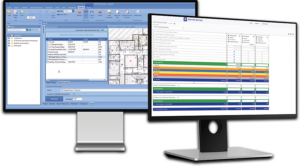How You Can Make the Bid Leveling Process Easier
Is mitigating risk a large part of your job? No?
If change orders are something you’re okay with, then you probably don’t care that 94% of Excel spreadsheets have errors.
If you are cranking out the lowest numbers just to win bids and running into cost overruns and budget delays down the road, then that’s none of our business. But if you care about providing a high-quality product and winning more work, then this advice is for you.
We gathered three experienced preconstruction experts: Steve Meeks, Vice President of Preconstruction & Estimating at S.M. Wilson & Company; Robbie Gronbach, Director of Preconstruction at Willis A. Smith Construction; and Lauren Senska, Implementation Specialist at Beck Technology to talk about how they’ve made bid day and bid leveling easier, more efficient, and way less stressful for everyone.
Why Your Current Bid Day Process Isn’t Working
Collectively, Lauren, Robbie, and Steve nailed down nine reasons why the typical bid day process is problematic, chaotic, and inherently risky:
- Relying on Excel and Google Sheets
- Pen and paper are still being used.
- Lots of data stored in people’s memories.
- Fax machines are still going.
- It’s hard to fully prepare ahead of time.
- Challenging to view and compare bids.
- Difficult to help when someone falls behind.
- Loss of time managing spreadsheets
- Hard to collaborate as a team.
Are you experiencing any of these? Then you know that these methods don’t support an efficient bid day process.
The Problem with Excel for Bid Leveling

At Willis A. Smith, 99 percent of their projects are negotiated, so preconstruction is involved early on, and receive competitive market feedback during the design process. However, working in Excel was “cumbersome.” For Robbie two of the biggest challenges using Excel for bid leveling were making sure all the formulas were correct and him being the only resource for data.
Robbie points out that even though “Excel is the staple template for estimating,” it still has its flaws and limitations, “It wasn’t built with the needs of the construction industry in mind. Everyone dreads the day that we have to combine those tabs and comb through the entire file to proof formulas and make sure everything is linked and formatted correctly. It’s full of risk. There’s a huge potential for mistakes. The formulas are flawed. Costs are miscalculated or there’s a typo in the spreadsheet and this can wreak havoc. Just one small data entry could easily cost you millions of dollars.”
Further, Excel doesn’t capture and store all your data in one place. Robbie says, “With historical costs, we always need to look back at how we performed on certain projects or how subs responded, and I would dig through all of those paper files. Basically, I was the historical cost database.” This is problematic because if your source of data is out or has left the company, how do you retrieve that information so you can continue working on the project?
For Steve, working in Excel hindered his team’s collaboration. He says, “We got to the point to where we need to be able to collaborate with multiple people. We have people working on bids that aren’t even in the same building. In addition to our estimators, our bid day process also includes our operational team members, so they need access as well.”
If you are using Excel for estimating and bid leveling, you are completely aware that your team has to create multiple versions of one file, making it extremely difficult to share that information. You have no idea what changes are made or when that file is updated. Lauren says, “It’s difficult to maintain consistency in Excel. It doesn’t automatically support a standardized approach for the multiple users and if there’s inconsistency in terms of format or content, then that can create problems on the backend for accounting and project management teams or for when you try and import that information for use again later. It gives too much opportunity for error and lacks the appropriate level of security.”
How to Fix Your Bid Leveling Process 
Now that we all agree that the bid leveling process is broken, how can you fix it? The answer is: by implementing innovative bid leveling software like DESTINI Bid Day that pulls all your bids into one program and allows you to quickly compare the information in each bid. With DESTINI Bid Day, you can level as a team, assess where risks are in bids, capture bid numbers alongside your estimates, and recommend project decisions based on data.
Steve says, “We believe that in order to stay competitive, we need to embrace technology as it comes available.” And technology designed to identify and mitigate risk in construction is how preconstruction teams are helping their companies win repeat work. Lauren says, “More construction companies are starting to prioritize risk identification and management. Risk is one of the most overlooked aspects of bid day.”
Access to historical cost information in DESTINI Bid Day will be “huge” for Robbie and his team. He says, “Having all that information stored in one platform will make it incredibly easy to go back through and collect certain pieces of information. That will ultimately improve our whole approach. We’ll be able to make project decisions based on bid data instead of guessing.”
For both Steve and Robbie, having all team members work in the same file at the same time is a game-changer. Robbie says, “For the first time ever we can actually work together as one team which is a huge stress reliever for everybody.”
Steve agrees, “The impact has been huge for us. Now when somebody on my team needs help, I can see exactly where they are. I can put as many people as I want into a single bid package. We can stay on top of a difficult bid package…”
The time savings have been huge. You can provide support right when it’s needed. No more stopping the process. Steve comments, “We quickly and simply determine where the numbers come from. Having this ability that we did not have even two years ago has changed a lot for us.” Robbie says, “Having a bid leveling software platform with formulas built-in means that we don’t have to worry about verifying them all the time.” Being able to speed up the bid day process means you can focus on other details or work on another project. Robbie mentions, “Whether you take time to measure those time savings or not, it’s obviously a more productive work environment.”
With its ability for you to put easily put checks and balances in your bid day process, DESTINI Bid Day bid leveling software reduces problems and reduces stress.
There are more benefits Robbie, Steve, and Lauren talk about during this discussion, like keeping employees happy and engaged, and automatic updates. To listen to the entire conversation, click here.

-1.png?width=112&height=112&name=image%20(4)-1.png)















